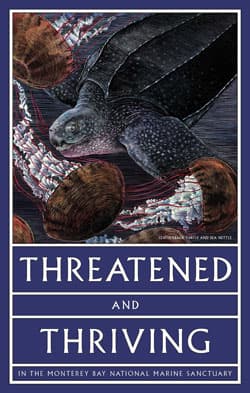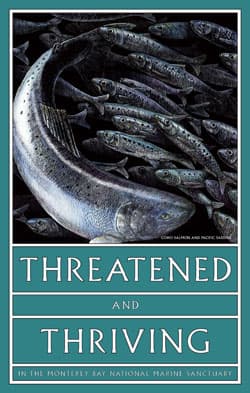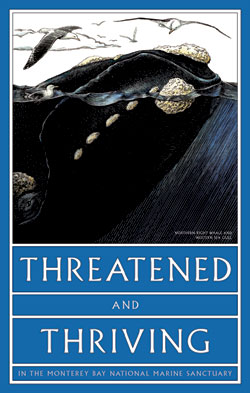Threatened and Thriving Poster Series
As part of our 10th anniversary celebration, the Monterey Bay National Marine Sanctuary produced this natural history series highlighting twelve species whose populations are either facing survival challenges, or are doing well.
Six beautiful 14" X 22" original art posters depict one threatened and one thriving species. The back of each poster contains natural history information. Kirsten Carlson, a scientific illustrator created the posters, presenting the organisms in a dramatic style. She used live organisms, photographs and film to help her in the development of the illustrations. The poster images can be printed below in 8.5" X 11" format or 11" X 14" format. |
|
|



|
Blue whales are the largest creatures on Earth, reaching an average length of 85-100 feet. They once were plentiful, but whaling led to their decline. They feed on tiny shrimp-like crustaceans, krill that can be found in clusters of billions of individuals. |
|
TOP


|
|
The leatherback is the largest of all the sea turtles and also the most endangered. Leatherbacks travel the world's oceans seeking their favorite food source, jellyfish. Click on the left to view the front of the poster for Leatherback Sea Turtles and Sea Nettles. |
|
TOP


| |
A diminutive shorebird, the Pacific population of the western snowy plover is now one of the most endangered species in the United States. Elephant seals, the largest pinnipeds in the northern hemisphere, were once hunted to near extinction. Now they are thriving in many parts of California. |
|
TOP


| |
The Coho, or silver salmon is an anadromous fish. It is born in fresh water and spends its adult life at sea. The loss of available spawning streams and fishing pressures have caused this species to decline. The Pacific sardine was once the most important commercially harvested fish in California. After numbers dropped drastically in the 1950's, this little fish is thriving once again. |
|
TOP


|
The North Pacific right whale became one of the world's most endangered mammals after it was hunted to near extinction by whalers. Current population estimates are between 400 and 900 individuals, with several recent sightings in the Monterey Bay National Marine Sanctuary. In contrast, the western gull thrives along the California coast, with more than 50,000 breeding age birds. Western gulls are supreme opportunists, feeding on fish, invertebrates and even human garbage. Their adaptability is their greatest survival skill. |
|
TOP


|
The Monterey Bay National Marine Sanctuary is one of the best places in the world to see the southern sea otter, which can be found around kelp forests and along rocky shorelines. Once hunted to near extinction for its lush fur, the sea otter population is still threatened by environmental toxins and disease. Sea otters are often seen wrapped up in giant kelp. Kelp forests provide oxygen, nutrients and habitat for a variety of invertebrates and fish species. Some of the lushest kelp forests in the world occur in the Monterey Bay National Marine Sanctuary. |
|
TOP

![]()
![]()




![]()
![]()



![]()






